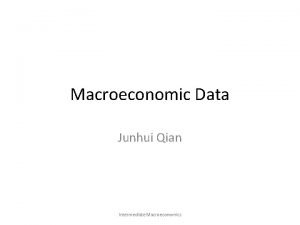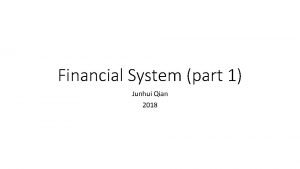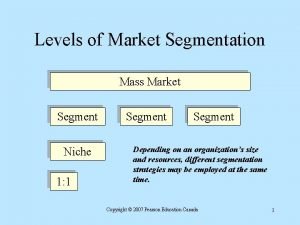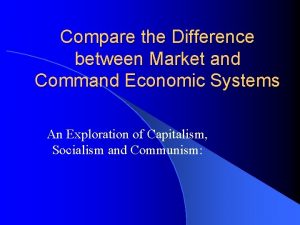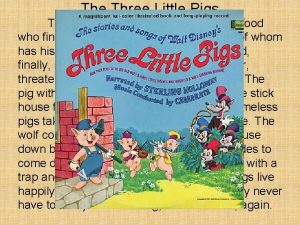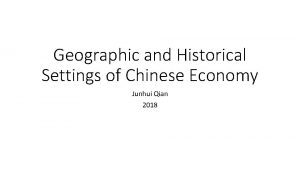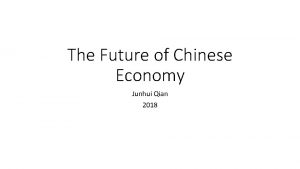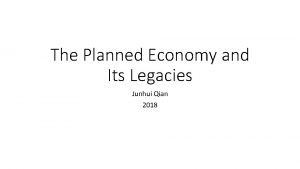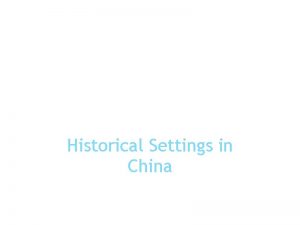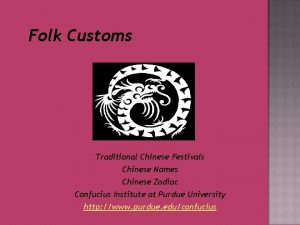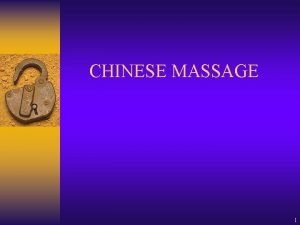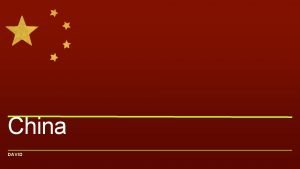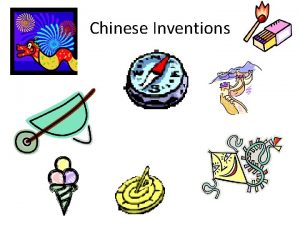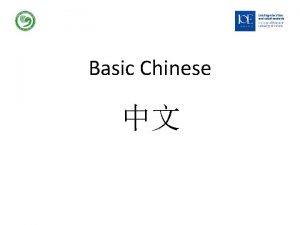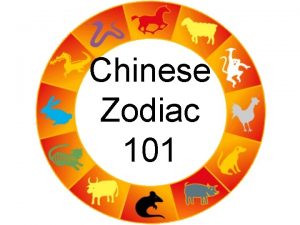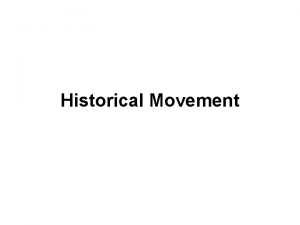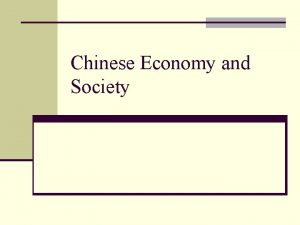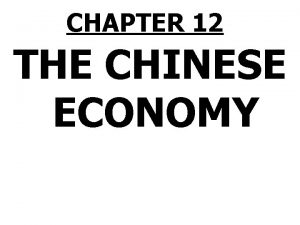Geographic and Historical Settings of Chinese Economy Junhui





























- Slides: 29

Geographic and Historical Settings of Chinese Economy Junhui Qian 2018

Content • The geographic setting • A brief history of Chinese economy • Before 1949

Why geography is important? • Agriculture depends on geography and precipitation. • “Initial conditions” for recent development. • The geography setting provides the natural boundary for the clustering of people and business. • The location and distribution of rivers and coasts


Provinces and Regions • China has 31 province-level administrative units, including 22 provinces, 4 municipalities under national supervision, and 5 autonomous regions of ethnic minorities. • There are large and small ones, old and new ones, rich and poor ones. • China has the longest combined land border in the world. • China's coastline along the Pacific is bounded by the Bohai, Yellow, East China and South China seas.


Landscape • Mountain ranges and high plateaus sit in the west. • Alluvial plains are in the east. • Mongolian plateau in the north features grasslands. • In the south, there are predominately hills and low mountain ranges.


Climates • There are roughly five climate types in China • • • Tropical Subtropical monsoon Temperate continental Mountainous • Partly due to the high altitude of the Tibetan plateau, it is very dry in the northwest.




Rivers • Major rivers include • • • Yangtze Yellow Xi Huai Amur • The deltas of Yangtze and Xi are economically the most important. • The Great Canal, from Beijing to Hangzhou, is the longest as well as one of the oldest canal in the world. It played an important role in the ancient economy of China.


The Chinese Economy Before 1949

Historical Division • Ancient history: • Xia dynasty c. 2070 – c. 1600 BC • Shang dynasty c. 1600 – c. 1046 BC • Zhou dynasty c. 1046 – 256 BC • Western Zhou • Eastern Zhou • • Spring and Autumn Warring States • Dynasties (221 BC-1911) • Republic of China (1911 -1949, 1949 - on Taiwan) • People’s Republic of China (from 1949, on mainland)

Dynasties (221 BC-1911)

The Traditional Economy • Dominantly agricultural • Small-scale household economy • Signs of commercialization emerged: • Sophisticated institutions (Money, large organizations, advanced commercial procedures, legal and customary institutions, banks) • Rather competitive markets for products, land, and labor.

From 《便民图纂》, a Ming book on agriculture in Taihu area.

Paper money of Ming Dynasty A Traditional Bank A Certificate of Tax

Small Government • Around 1800, one government worker per 32, 000 people. • What the government does: • • • Maintain a military Courier/postal/transport service Dams, canals, and public works Local security and law suits Disaster relief

A Simplistic Model • After years (decades) of chaos, a new dynasty would bring peace and stability to China. • Farmers start to live better. And as they have more children, population increases. • The new dynasty would repair and construct dams and canals, so that more land would be available for more population. • Arable land is limited, but population continues to expand, diminishing return to labor and hence standard of living. • During the decline of the dynasty, farmers would face increasing burden of tax, as politically important groups manage to lower or even waive their share. • With limited funding and widespread corruption, the public works (dams, canals, ) would be left dilapidated and bandits would appear. • Eventually, there would be large-scale of farmers uprising or/and barbarian invasion, ending the rule of the dynasty. • The cycle repeats.


The ultimate crisis of the traditional economy • Population growth on the limited land stagnant technology • “The Chinese peasant is like a man standing on tiptoe up to his nose in water —the slightest ripple is enough to drown him. ” (Tawney, 1930 s) • Failure of government • Widespread corruption • Too small, especially compared with the population boom in 18 and 19 centuries. • Challenge from the west • The opium import in 19 century caused a severe monetary deflation.

Why the Industrial Revolution Did Not Originate in China? • Needham’s puzzle: Why was China's science and technology so far in advance of other civilizations historically, only to fall in modem times? • Lin (1995) points to the missing scientific revolution in China, which in turn may be due to the contents of civil service exams and the criteria of promotion.

1912 -1937 • Rapid industrialization (8%-9% annual growth in factory production) • Treaty ports (e. g. , Shanghai) • Manchuria • There were two good intervals: • 1914 -1918 (WWI) • 1927 -1937 (“The Nanjing Decade”) • Modern education expanded rapidly. • Open to the world • About 100, 000 Chinese students went abroad (Japan, US, Europe) • As of 1936, around 370, 000 foreigners were resident in China • Shanghai was the financial center of the far east.

1937 -1949 • War-time economy • Increased State Intervention • Before the war, there had been no significant public sector • By the early 1940 s, state-run firms accounted for 70% of all capital and 32% of all labor in unoccupied area. • Hyperinflation


Summary • Geographically, China is big and diverse. • The traditional economy is household-based and agricultural. The modernization of Chinese economy had been bumpy, frequently interrupted by wars and revolutions. • People’s Republic of China was been founded in desperate economic situation.
 Junhui qian
Junhui qian Junhui qian
Junhui qian Primary 3 malay worksheets
Primary 3 malay worksheets Athens and sparta were both
Athens and sparta were both Copyright
Copyright Dr jekyll and mr hyde settings
Dr jekyll and mr hyde settings Bipap settings for copd
Bipap settings for copd Group communication in health and social care
Group communication in health and social care Proper dinnerware placement
Proper dinnerware placement Settings time and place
Settings time and place Plot settings and characterization
Plot settings and characterization Handling information in health and social care
Handling information in health and social care Two types of advertisements
Two types of advertisements Segmentation de niche
Segmentation de niche Pros and cons of geographic segmentation
Pros and cons of geographic segmentation Geographic demographic and psychographic
Geographic demographic and psychographic Similarities between market and command economy
Similarities between market and command economy Social and historical context of romeo and juliet
Social and historical context of romeo and juliet Vray animation settings
Vray animation settings Vray render history
Vray render history Which display mode is allowed for proper navigation?
Which display mode is allowed for proper navigation? The three little pigs setting characters
The three little pigs setting characters What is the setting of the necklace
What is the setting of the necklace Hunger games setting description
Hunger games setting description The boy in striped pajamas setting
The boy in striped pajamas setting The alchemist climax
The alchemist climax Pacemaker settings
Pacemaker settings Teams voicemail greeting
Teams voicemail greeting The lion and the mouse conflict elements
The lion and the mouse conflict elements List of community roles
List of community roles
